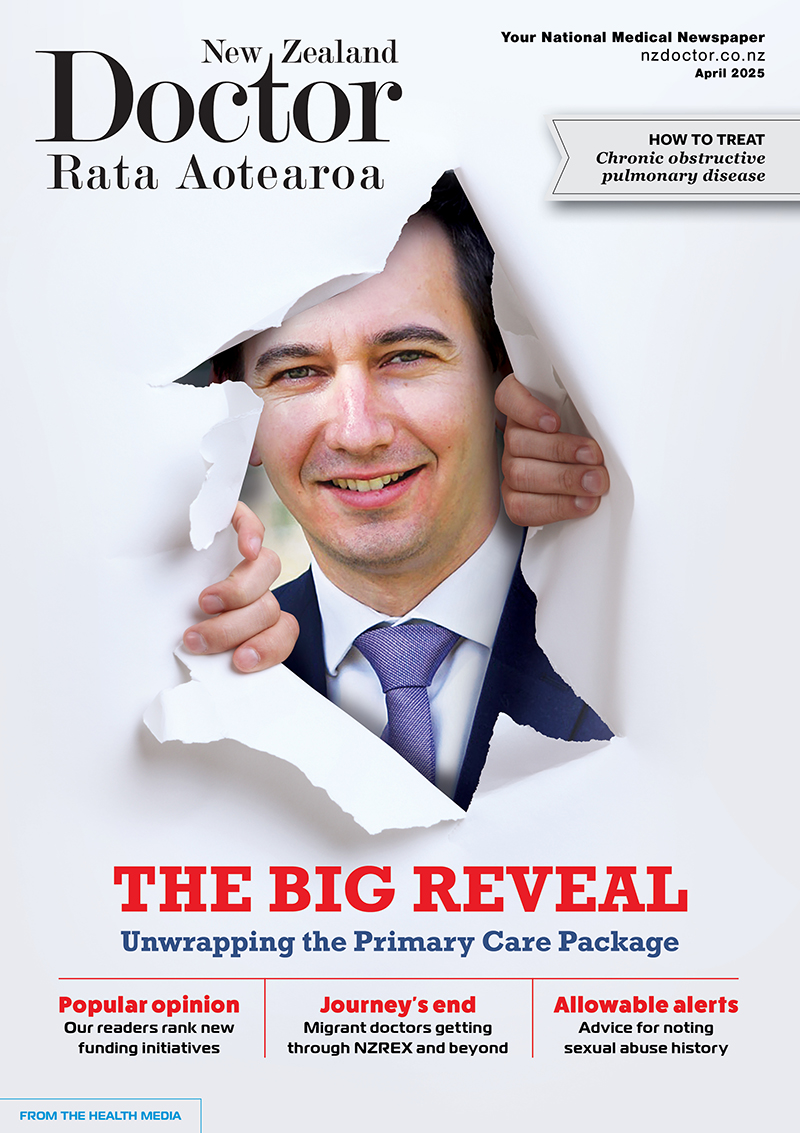Respiratory physician Lutz Beckert considers chronic obstructive pulmonary disease management, including the prevention of COPD, the importance of smoking cessation and pulmonary rehabilitation, and the lifesaving potential of addressing treatable traits. He also discusses the logic of inhaler therapy, moving from single therapy to dual and triple therapy when indicated, as well as other aspects of management
Landmark intensive care study shows significant Disparities in health outcomes for Māori patients
Landmark intensive care study shows significant Disparities in health outcomes for Māori patients

The first large-scale national study to compare health outcomes for Māori and European patients admitted to New Zealand intensive care units (ICU) has been published today in the New Zealand Medical Journal.
The Medical Research Institute of New Zealand (MRINZ) compared and analysed data frommore than 50,000 patients admitted to all major hospital ICUs over a 10-year period, finding that Māori patients were more likely than European patients to die within 180 days of ICU admission.
The study, Outcomes for Māori and European patients admitted to New Zealand intensive care units between 2009 and 2018, was led by the MRINZ, on behalf of the Australian and NewZealand Intensive Care Society (ANZIC) CORE Management Committee, a leading advocate in critical care.
The study found that Māori are 13 years younger on average when admitted to ICU than European patients. Despite this, Māori patients have more chronic underlying conditions when they are admitted to ICU, including diabetes and kidney disease, and are, on average, more severely unwell and have a higher risk of dying.
Professor Paul Young, MRINZ Deputy Director, Intensive Care Specialist, and study seniorauthor says, “Importantly, when we accounted for underlying conditions and how unwellpatients were on hospital arrival, there was no difference in survival rates between Māori andEuropean patients. This implies that differences in health outcomes are unlikely to be related tothe care being delivered after patients get to the ICU.”
The observation that Māori ICU patients are much younger than European ICU patients and stillhave more underlying diseases or medical conditions than their European counterparts implies that an unequal burden of chronic conditions is a major contributor to inequality in ICU outcomes. Another potential factor is that barriers to accessing prompt care for Māori might potentially contribute to higher illness severity by the time of ICU admission.
“Health inequalities are an ongoing major public health concern and a strong focus for theMedical Research Institute of New Zealand. says Professor Young. “Māori are likely to be ill farmore frequently, suffer disproportionately high levels of disease, and die younger than non-Māori of the same socioeconomic status. There are also differences in broader societal issues that significantly affect health, including housing, education, employment, and socioeconomic deprivation.”
Dr James Moore, MRINZ Clinical Research Fellow and Intensive Care Specialist, says. “GivenMāori are much more likely than European patients to be admitted to the ICU with lifethreatening infections, after major trauma, and following a cardiac arrest, these study findings are hugely important in identifying priorities for future research that has the potential to lead to change in clinical practice, and support equitable Māori health outcomes.”
Key points at a glance
1. The first large-scale national study to compare outcomes for Māori and European patientsadmitted to New Zealand intensive care units (ICU) shows that Māori patients were more likelythan European patients to die within 180 days of ICU admission.
2. Māori are 13 years younger on average when admitted to ICU than European patients. Despitethis, Māori patients have more chronic conditions when they are admitted to ICU (including diabetes and kidney disease), and are, on average, more severely unwell and have a higherchance of dying.
3. When underlying conditions and severity of illness were accounted for, there was nodifference in survival rates between Māori and European patients. This implies that differencesin health outcomes are unlikely to be related to the care being delivered after patients arrive atan ICU.
4. Outcomes for Māori and European patients admitted to New Zealand intensive care unitsbetween 2009 and 2018 was authored by Dr Alice Reid, Professor Michael Bailey, Professor Matire Harwood, Dr James Moore, and Professor Paul Young, on behalf of the ANZICS COREManagement Committee.
5. Given Māori are more likely than European patients to be admitted to the ICU with lifethreateninginfections, after major trauma, and following a cardiac arrest, continuing toinvestigate these conditions in Māori patients should be a priority and focus for ongoing criticalcare research in Aotearoa.
6. The Medical Research Institute of New Zealand (MRINZ) is committed to improving thecollection, monitoring, analysis, and reporting of quality ethnicity data, actively supporting moreequitable health outcomes for Māori and Pasifika patients in Aotearoa New Zealand.
Background trial detail
This cohort study describes characteristics and outcomes of Māori and European patientsadmitted to New Zealand intensive care units (ICUs) between June 2009 and 2018.New Zealand Ministry of Health National Minimum Dataset matched to the Australia NewZealand Intensive Care Society Centre for Outcome and Resource Evaluation Adult PatientDatabase.
The primary outcome was day-180 mortality. Secondary outcomes were ICUmortality, hospital mortality, discharge to home, ICU length of stay, hospital length of stay andsurvival time.
We report associations between Māori ethnicity and each outcome, with Europeanas the reference category, using regression analyses to adjust sequentially for site, deprivationstatus, gender, year of admission, the Charlson comorbidity index, age, admission source andtype, ICU admission diagnosis, ventilation status and illness severity based on physiologicalparameters.
A total of 52,552 patients from 17 ICUs were included in this study.Māori admitted to ICU were on average 13 years younger than European patients.
A total of 968of 9,681 (10%) Māori and 2,732 of 42,871 (5.2%) European were admitted after trauma, and 740of 9,681 (7.6%) and 2,318 of 42,871 (4.4%) were admitted with sepsis, respectively. A total of1,550 of 9,681 (16.0%) Māori and 6,407 of 42,871 (14.9%) European patients died within 180days of ICU admission; odds ratio (OR) 1.08; 95% CI, 1.02 to 1.15.
When adjusted for age, the ORfor day-180 mortality for Māori versus European patients increased substantially.
The ORdecreased after adjustment for admission source and type, and after accounting for Māorihaving a higher comorbidity index and more severe illness than European patients. In the finalmodel, incorporating adjustment for all specified variables, Māori ethnicity was not associatedwith day-180 mortality (adjusted OR 1.01; 95%CI, 0.92 to 1.10). Findings were similar for allsecondary outcomes.
Compared to European patients, Māori were markedly more likely to be admitted to the ICUafter trauma or with sepsis.
Despite Māori being on average 13 years younger at ICU admissionthan their European counterparts, they had more co-morbidities, higher illness severity and ahigher risk of dying within 180 days (about 6 months).




![Barbara Fountain, editor of New Zealand Doctor Rata Aotearoa, and Paul Hutchison, GP and senior medical clinician at Tāmaki Health [Image: Simon Maude]](/sites/default/files/styles/thumbnail_cropped_100/public/2025-03/Barbara%20Fountain%2C%20editor%20of%20New%20Zealand%20Doctor%20Rata%20Aotearoa%2C%20and%20Paul%20Hutchison%2C%20GP%20and%20senior%20medical%20clinician%20at%20T%C4%81maki%20Health%20CR%20Simon%20Maude.jpg?itok=-HbQ1EYA)
![Lori Peters, NP and advanced health improvement practitioner at Mahitahi Hauora, and Jasper Nacilla, NP at The Terrace Medical Centre in Wellington [Image: Simon Maude]](/sites/default/files/styles/thumbnail_cropped_100/public/2025-03/2.%20Lori%20Peters%2C%20NP%20and%20advanced%20HIP%20at%20Mahitahi%20Hauora%2C%20and%20Jasper%20Nacilla%2C%20NP%20at%20The%20Terrace%20Medical%20Centre%20in%20Wellington%20CR%20Simon%20Maude.jpg?itok=sUfbsSF1)
![Ministry of Social Development health and disability coordinator Liz Williams, regional health advisors Mary Mojel and Larah Takarangi, and health and disability coordinators Rebecca Staunton and Myint Than Htut [Image: Simon Maude]](/sites/default/files/styles/thumbnail_cropped_100/public/2025-03/3.%20Ministry%20of%20Social%20Development%27s%20Liz%20Williams%2C%20Mary%20Mojel%2C%20Larah%20Takarangi%2C%20Rebecca%20Staunton%20and%20Myint%20Than%20Htut%20CR%20Simon%20Maude.jpg?itok=9ceOujzC)
![Locum GP Helen Fisher, with Te Kuiti Medical Centre NP Bridget Woodney [Image: Simon Maude]](/sites/default/files/styles/thumbnail_cropped_100/public/2025-03/4.%20Locum%20GP%20Helen%20Fisher%2C%20with%20Te%20Kuiti%20Medical%20Centre%20NP%20Bridget%20Woodney%20CR%20Simon%20Maude.jpg?itok=TJeODetm)
![Ruby Faulkner, GPEP2, with David Small, GPEP3 from The Doctors Greenmeadows in Napier [Image: Simon Maude]](/sites/default/files/styles/thumbnail_cropped_100/public/2025-03/5.%20Ruby%20Faulkner%2C%20GPEP2%2C%20with%20David%20Small%2C%20GPEP3%20from%20The%20Doctors%20Greenmeadows%20in%20Napier%20CR%20Simon%20Maude.jpg?itok=B0u4wsIs)
![Rochelle Langton and Libby Thomas, marketing advisors at the Medical Protection Society [Image: Simon Maude]](/sites/default/files/styles/thumbnail_cropped_100/public/2025-03/6.%20Rochelle%20Langton%20and%20Libby%20Thomas%2C%20marketing%20advisors%20at%20the%20Medical%20Protection%20Society%20CR%20Simon%20Maude.jpg?itok=r52_Cf74)
![Specialist GP Lucy Gibberd, medical advisor at MPS, and Zara Bolam, urgent-care specialist at The Nest Health Centre in Inglewood [Image: Simon Maude]](/sites/default/files/styles/thumbnail_cropped_100/public/2025-03/7.%20Specialist%20GP%20Lucy%20Gibberd%2C%20medical%20advisor%20at%20MPS%2C%20and%20Zara%20Bolam%2C%20urgent-care%20specialist%20at%20The%20Nest%20Health%20Centre%20in%20Inglewood%20CR%20Simon%20Maude.jpg?itok=z8eVoBU3)
![Olivia Blackmore and Trudee Sharp, NPs at Gore Health Centre, and Gaylene Hastie, NP at Queenstown Medical Centre [Image: Simon Maude]](/sites/default/files/styles/thumbnail_cropped_100/public/2025-03/8.%20Olivia%20Blackmore%20and%20Trudee%20Sharp%2C%20NPs%20at%20Gore%20Health%20Centre%2C%20and%20Gaylene%20Hastie%2C%20NP%20at%20Queenstown%20Medical%20Centre%20CR%20Simon%20Maude.jpg?itok=Z6u9d0XH)
![Mary Toloa, specialist GP at Porirua and Union Community Health Service in Wellington, Mara Coler, clinical pharmacist at Tū Ora Compass Health, and Bhavna Mistry, specialist GP at Porirua and Union Community Health Service [Image: Simon Maude]](/sites/default/files/styles/thumbnail_cropped_100/public/2025-03/9.%20Mary%20Toloa%2C%20Porirua%20and%20Union%20Community%20Health%20Service%20in%20Wellington%2C%20Mara%20Coler%2C%20T%C5%AB%20Ora%20Compass%20Health%2C%20and%20Bhavna%20Mistry%2C%20PUCHS%20CR%20Simon%20Maude.jpg?itok=kpChr0cc)